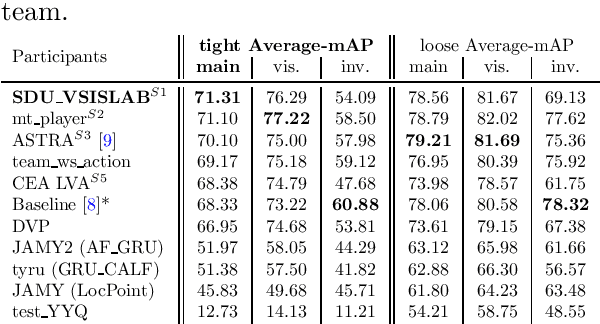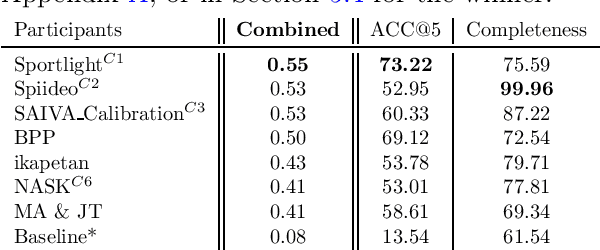Julien Denize
SoccerNet 2023 Challenges Results
Sep 12, 2023



Abstract:The SoccerNet 2023 challenges were the third annual video understanding challenges organized by the SoccerNet team. For this third edition, the challenges were composed of seven vision-based tasks split into three main themes. The first theme, broadcast video understanding, is composed of three high-level tasks related to describing events occurring in the video broadcasts: (1) action spotting, focusing on retrieving all timestamps related to global actions in soccer, (2) ball action spotting, focusing on retrieving all timestamps related to the soccer ball change of state, and (3) dense video captioning, focusing on describing the broadcast with natural language and anchored timestamps. The second theme, field understanding, relates to the single task of (4) camera calibration, focusing on retrieving the intrinsic and extrinsic camera parameters from images. The third and last theme, player understanding, is composed of three low-level tasks related to extracting information about the players: (5) re-identification, focusing on retrieving the same players across multiple views, (6) multiple object tracking, focusing on tracking players and the ball through unedited video streams, and (7) jersey number recognition, focusing on recognizing the jersey number of players from tracklets. Compared to the previous editions of the SoccerNet challenges, tasks (2-3-7) are novel, including new annotations and data, task (4) was enhanced with more data and annotations, and task (6) now focuses on end-to-end approaches. More information on the tasks, challenges, and leaderboards are available on https://www.soccer-net.org. Baselines and development kits can be found on https://github.com/SoccerNet.
COMEDIAN: Self-Supervised Learning and Knowledge Distillation for Action Spotting using Transformers
Sep 03, 2023



Abstract:We present COMEDIAN, a novel pipeline to initialize spatio-temporal transformers for action spotting, which involves self-supervised learning and knowledge distillation. Action spotting is a timestamp-level temporal action detection task. Our pipeline consists of three steps, with two initialization stages. First, we perform self-supervised initialization of a spatial transformer using short videos as input. Additionally, we initialize a temporal transformer that enhances the spatial transformer's outputs with global context through knowledge distillation from a pre-computed feature bank aligned with each short video segment. In the final step, we fine-tune the transformers to the action spotting task. The experiments, conducted on the SoccerNet-v2 dataset, demonstrate state-of-the-art performance and validate the effectiveness of COMEDIAN's pretraining paradigm. Our results highlight several advantages of our pretraining pipeline, including improved performance and faster convergence compared to non-pretrained models.
Similarity Contrastive Estimation for Image and Video Soft Contrastive Self-Supervised Learning
Dec 21, 2022Abstract:Contrastive representation learning has proven to be an effective self-supervised learning method for images and videos. Most successful approaches are based on Noise Contrastive Estimation (NCE) and use different views of an instance as positives that should be contrasted with other instances, called negatives, that are considered as noise. However, several instances in a dataset are drawn from the same distribution and share underlying semantic information. A good data representation should contain relations between the instances, or semantic similarity and dissimilarity, that contrastive learning harms by considering all negatives as noise. To circumvent this issue, we propose a novel formulation of contrastive learning using semantic similarity between instances called Similarity Contrastive Estimation (SCE). Our training objective is a soft contrastive one that brings the positives closer and estimates a continuous distribution to push or pull negative instances based on their learned similarities. We validate empirically our approach on both image and video representation learning. We show that SCE performs competitively with the state of the art on the ImageNet linear evaluation protocol for fewer pretraining epochs and that it generalizes to several downstream image tasks. We also show that SCE reaches state-of-the-art results for pretraining video representation and that the learned representation can generalize to video downstream tasks.
Similarity Contrastive Estimation for Self-Supervised Soft Contrastive Learning
Nov 29, 2021



Abstract:Contrastive representation learning has proven to be an effective self-supervised learning method. Most successful approaches are based on the Noise Contrastive Estimation (NCE) paradigm and consider different views of an instance as positives and other instances as noise that positives should be contrasted with. However, all instances in a dataset are drawn from the same distribution and share underlying semantic information that should not be considered as noise. We argue that a good data representation contains the relations, or semantic similarity, between the instances. Contrastive learning implicitly learns relations but considers the negatives as noise which is harmful to the quality of the learned relations and therefore the quality of the representation. To circumvent this issue we propose a novel formulation of contrastive learning using semantic similarity between instances called Similarity Contrastive Estimation (SCE). Our training objective can be considered as soft contrastive learning. Instead of hard classifying positives and negatives, we propose a continuous distribution to push or pull instances based on their semantic similarities. The target similarity distribution is computed from weak augmented instances and sharpened to eliminate irrelevant relations. Each weak augmented instance is paired with a strong augmented instance that contrasts its positive while maintaining the target similarity distribution. Experimental results show that our proposed SCE outperforms its baselines MoCov2 and ReSSL on various datasets and is competitive with state-of-the-art algorithms on the ImageNet linear evaluation protocol.
 Add to Chrome
Add to Chrome Add to Firefox
Add to Firefox Add to Edge
Add to Edge